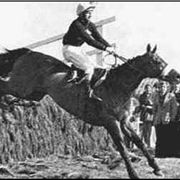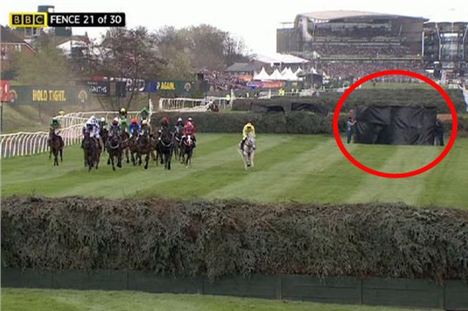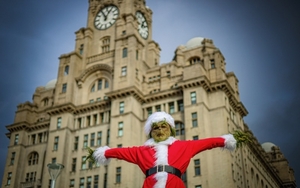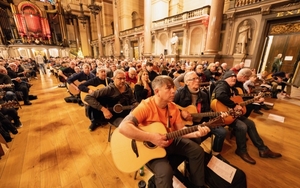MY love of the Grand National was sown in the mid 1970s. Boom Docker, Spanish Steps, The Pilgarlic, Rag Trade, Greasepaint, L’Escargot and of course Red Rum - names as familiar to me now as those of classmates at junior school.
“One at a time...one at a time!” my dad would plead as we three kids divvied up the horses in the family sweepstake, each name carefully snipped from the Daily Express.
The British Horseracing Authority’s safety and welfare review, following the two fatalities in
2011, suggested a mix of minor concessions
and PR recommendations - plenty of tweaks
but few of real substance
I would sit cross legged in front of the TV with my seven or eight horses neatly arranged on the carpet in front of me, transfixed by the BBC commentary of Peter O’Sullevan, John Hamner, Julian Wilson and Michael O’Hehir. My back would arch, my head bob with each fence.
O’Sullevan’s breathless words to accompany Red Rum’s 1977 win also live on: “..it’s hats off and a tremendous reception. You’ve never heard one like it at Liverpool”.
From the 1970s, perhaps inspired by Rummy - the people’s champion - the Grand National has gone from the brink of extinction under the ownership of property developer Bill Davies to blossom into a mainstream sporting event accommodating the corporate market, traditional racing folk and, on a wider level, fun-loving party girls and families.
For many years it was a privilege for me to work as a journalist at the Grand National and to witness the relentless growth in media interest as the Aintree brand spread its appeal and went global.
The race is now broadcast to 600 million people across 140 countries. Since 1993 attendances at Aintreee have almost doubled to this year’s modern-day record of 155,000, helped by clever, classy marketing and generous sponsorship, primarily from French Cognac firm Martell and beer makers John Smith’s.
I now preside over the next generation of family sweepstake. “One at a time...!” I cry, as four sets of young hands divvy up the 40-strong field. New names have brought the same excitement as I enjoyed. Hedgehunter, Black Apalachi, Silver Birch, Snowy Morning.
This year, though, everything had changed. There was little excitement. Our older children, aged nine and 11, remembered the deaths of two horses in the 2011 race and the fatal collapse of Hear the Echo in 2009.
This year the kids were more concerned about horses falling, screens being put up and fences being bypassed. The subsequent deaths of Gold Cup winner Synchronised and According to Pete in the 2012 race compounded their doubts, making us grown-ups look even sillier in their eyes.
These are watershed times for the Grand National. I fear that it will lose a generation of fans unless more is done to reduce the risk of horse deaths and in turn protect its reputation.
It is clear that the racing fraternity is wary of radical changes. They also seem irritated by non-racing people expressing a view about the Grand National, perhaps because they feel their livelihoods are being threatened.
“Facts” are often rolled out to claim that the race is getting safer. Other people will state that over the last two years each horse has statistically had twice the chance of dying than winning. Bang. That hits home the danger.
 Red Rum Hops Over Bechers
Red Rum Hops Over Bechers
Brook As If It Were A PuddleIt is accepted than eliminating risk is impossible without banning the race, something very few want. However, more significant, bolder changes are required to reduce the risk of fatalities.
With input from trainers, jockeys, owners, officials and animal welfare experts, the British Horseracing Authority’s safety and welfare review following the two fatalities in 2011 suggested a mix of minor concessions and PR recommendations - plenty of tweaks but few of real substance.
For example, snipping two inches off one of the fences will have a negligible effect on the race, for better or possibly worse. Smaller fences encourage bolder, faster jumping. Some worthwhile suggestions from the BHA, particularly on after-race care for horses, have been implemented.
So, what practical steps can be taken for 2013 to better safeguard the horses and in turn protect or enhance the Grand National’s character?
I could list many suggestions such as smoothing out the Canal Turn bend, scrapping the pre-race grandstand parade, watering for soft ground, employing outriders to corral riderless horses or fairly obvious ones such a banning “trick” or drop fences where the landing side is up to two feet lower than take-off.
However, I will focus on one. Many of the safety issues posed by the Grand National are undeniably a result of the high number of runners. Forty runners is far in excess of the Cheltenham Festival’s limit of 28 or the Welsh National (28), Irish National and Scottish National (both 30).
The current field size triggers an exciting charge to the first fence and by Becher’s Brook (Fence 6) - some 90 seconds into the nine-minute race - statistics tell us half those horses that will not complete the race have already fallen, unseated their rider or been brought down. Their race is run. After that things calm down noticeably.
Reducing the number of Grand National runners to around 30 is inevitable in the long-term, so it is sensible to make the decision now - even if it means some disgruntled trainers, jockeys or owners missing out.
It is hard to argue that the race would lose any character from having ten or so fewer runners - you could argue a place in the line-up is even more prestigious with less.
Alongside reducing the field size, the start system needs serious attention (it is often a bungling embarrassment which further stresses already twitchy horses and jockeys). The first fence could also be moved 50 metres nearer to hold up the field.
With arguably marginalised TV coverage from next year, when Channel 4 takes over from the BBC, and an emerging groundswell of opposition to the status quo from within racing circles, the great race faces a future as uncertain as that in the 1970s. It could easily slink away from the mainstream.
Thankfully, the Grand National is steeped in resilience, innovation and boldness - qualities it will need to regain its place in our hearts, and once again engage a generation of youngsters with colourful tales of sporting greatness.















